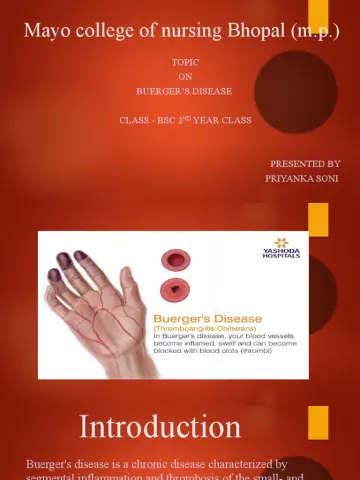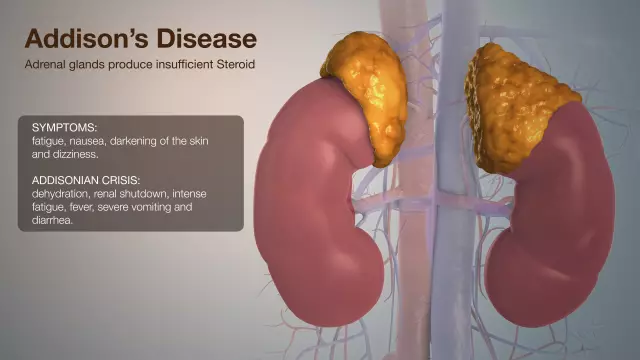- Author Rachel Wainwright [email protected].
- Public 2023-12-15 07:39.
- Last modified 2025-11-02 20:14.
Burger's disease

Buerger's disease is thromboangiitis obliterans - narrowing of veins and arteries of medium and small size in the upper and lower extremities as a result of the inflammatory process. In rare cases, the pathology manifests itself in the coronary, cerebral and visceral arteries.
The disease was described by the German physician Leo Burger in 1908, who hypothesized that it was this disease that caused 11 limb amputations he performed.
Traditionally, it is believed that Buerger's disease affects mainly smoking men aged 20-40 years. However, in recent years, cases of diagnosing the disease in women have become more frequent, which is explained by the spread of smoking among the fairer sex.
Despite the assumptions of experts, the etiology of the disease is not fully understood: there are indications regarding the influence of hereditary factors on the patient's body, in particular, the carriage of HLA antigens - B5 and A9, as well as the presence of antibodies directed against laminin, elastin and collagen I, III and IV types.
The clinical picture of Buerger's disease
Pathomorphologically, there is a gradual decrease in blood circulation in the arms or legs, starting from the distal parts (fingertips) and spreading proximally (upward). Inflammation of the arteries is characterized by cellular infiltrative processes in all three layers of the vascular wall: intimal lesions, cleavage of cell membranes, endothelial hyperplasia and severe thrombosis.
There are two main forms of lesion: peripheral and mixed. In the first form of Buerger's disease, the vessels or main arteries of the extremities are affected with characteristic symptoms of arterial ischemia of the legs, migratory thrombophlebitis, acrocyanosis, and ulceration. In the mixed form, along with signs of vascular lesions of the extremities, there are symptoms of damage to the heart, blood vessels of the brain, kidneys, changes in the lungs, and abdominal symptoms.
In the initial period of Buerger's disease, functional changes in the extremities are observed: chilliness of the legs, a feeling of numbness, and a feeling of "goose bumps". Patients report loss of sensitivity in the fingers, blue discoloration and pain. With damage to the vessels of the legs, a symptom of intermittent claudication appears - sharp painful sensations in the calf muscles while walking.
Against the background of the development of Buerger's disease, trophic disorders can be observed: hyperhidrosis, anhidrosis, hyperpigmentation, edema, atrophy of the skin, muscles, necrosis, trophic ulcers, gangrene.
Diagnosis of Buerger's disease
Often, the diagnosis of Buerger's disease is exclusive (in cases where the impossibility of the existence of other diseases with the above symptoms has been proven). The diagnosis of thromboangiitis obliterans can be made in the presence of the following aspects:
- The patient's age is younger than 40-45 years;
- The presence of signs of insufficient blood circulation in the tissues of the extremities with pain, lameness, ulcers, identified using non-invasive research methods (for example, Doppler ultrasound);
- Exclusion of diseases associated with blood clotting disorders, autoimmune diseases, diabetes mellitus;
- Pathological processes of a similar nature are detected both in the sick and in the apparently healthy limb.
For functional tests that would indicate violations of the blood supply to the extremities, the following are used:
- Oppel's plantar ischemia symptom (blanching of the affected limb raised upward);
- Goldflam test (the patient in the supine position performs exercises for flexion and extension of the knee and hip joints. With severe circulatory disorders, the patient feels tired after 10 manipulations);
- Panchenko's knee phenomenon (a patient in a sitting position, having thrown his injured leg over his healthy one, begins to experience sensations of numbness, pain in the affected limb).
Treatment of Burger's disease

Currently, there are no effective treatments for Buerger's disease. In the early stages of thromboangiitis obliterans, experts recommend conservative treatment associated with:
- Elimination of the effect of etiological factors on the disease (in particular, smoking cessation);
- Pain relief;
- Elimination of vascular spasm using ganglion blockers and antispasmodics;
- Normalization of blood clotting processes, improvement of its rheological properties;
- Improving metabolic processes in tissues.
In the absence of a positive effect from conservative therapy, the prerequisites for surgical intervention arise. In order to relieve spasm of peripheral arteries, surgeons perform lumbar sympathectomy. If the vessels of the upper extremities are involved in the pathological process, thoracic sympathectomy is performed. There is also information about the positive effect of hyperbaric oxygenation and plasmapheresis on the course of Buerger's disease, however, these methods are not generally accepted.
The effectiveness of an alternative therapy for Buerger's disease, which is undergoing clinical trials - stem cell injections - has not yet been officially confirmed.
The appearance of necrosis and gangrene on the affected limbs is an indication for amputation. According to statistics, approximately 35% of patients with this diagnosis cannot avoid surgical removal of the limbs.
Recommendations
A person suffering from Buerger's disease must immediately quit smoking - otherwise the disease will only progress. In addition, the patient should avoid damage to the skin due to exposure to high or low temperatures, chemicals, injuries associated with wearing uncomfortable shoes, performing minor operations (for example, removing calluses), fungal infections.
All patients (except for patients with ulcers and gangrene on the affected limbs) are recommended to walk for a short time (20-30 minutes) several times a day.
YouTube video related to the article:
The information is generalized and provided for informational purposes only. At the first sign of illness, see your doctor. Self-medication is hazardous to health!






